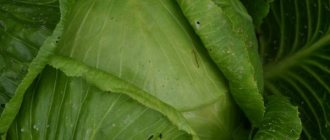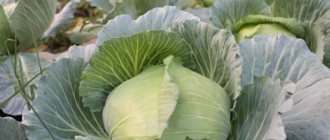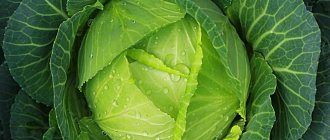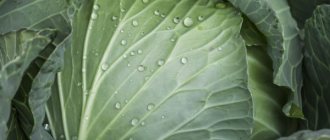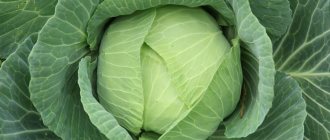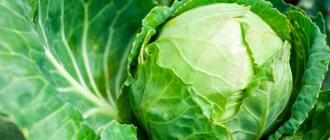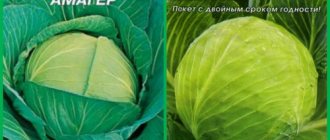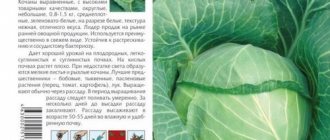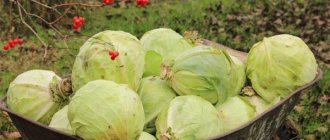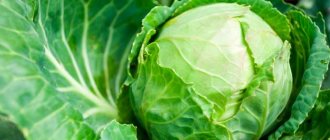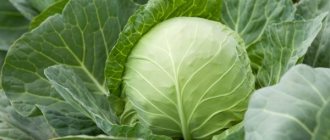Menza F1 cabbage is highly valued for its commercial and taste qualities, long-lasting shelf life (the harvest collected in the fall is stored until March). The hybrid was bred by breeders from Holland in the last century and has been included in the State Register since 1960.
| Landing location | Ripening time | View | Purpose | Origin | Maturation period | Weight |
| Open ground | Mid-late | White cabbage | Long-term storage, fermentation, cooking | Hybrid | 90-95 | 3 |
History of selection
Mensa F1 is a hybrid of white cabbage, bred in the Netherlands in the 50s of the twentieth century. Its original name is translated from Dutch as “dining room”.
The new hybrid was quickly appreciated by professional agronomists. Like many other countries, the USSR, after testing by the relevant State Commission in 1960, included it in the State Register, officially recommending it for landing in the vast majority of regions (Menza is not suitable only for the subarctic climate).
The hybrid is not included in the Russian State Register, but this does not prevent gardeners from actively growing it. Menza is popular not only in Russia, but also in the republics of the former USSR. Now domestic breeders are actively using it to develop new varieties and hybrids intended for cultivation in the Far East.
In Russia, seeds of the Menza F1 variety are produced by different agricultural companies. Important! Menza F1 is a hybrid, not a variety of white cabbage. Its propagation by seeds collected from independently grown specimens is impossible.
Description of Menza cabbage variety and characteristics
White cabbage Menza F1 is a mid-season hybrid. Depending on the growing region and the weather in summer, heads of cabbage may take longer to form, at a time more typical for mid-late varieties. The approximate period of harvest ripening is 105-115 days. Heads of cabbage can be harvested in the second half of August or in the first ten days of September.
The plants are quite large, the rosette of leaves is at least 40 cm in diameter. The leaves are large, leathery, with a slightly wavy edge. They are colored in a typical cabbage green color with a grayish-gray undertone.
The heads of cabbage are almost regular spherical in shape, very dense, and snow-white when cut. The stalk is not large. Their average weight is 3-4 kg. But record-breaking specimens weighing up to 9-12 kg are not uncommon for Menza cabbage. Amateur gardeners can count on a yield of 10-12 kg/m².
The vast majority of Menza cabbage heads (about 95%) are marketable. They do not crack or fall to the ground under their own weight. The latter is generally surprising, given that the stem is relatively thin.
Heads of Menza variety look very presentable
The taste is classic “cabbage”, slightly sweet, without the slightest bitterness. The leaves are very juicy, their crunch remains even after pickling. The purpose of Menza cabbage is universal. It is good both in fresh vegetable salads and in soups, main courses, and home canning for the winter.
Menza heads of cabbage do not lose their taste, juiciness and density during transportation and storage. In optimal or close to optimal conditions, it will last at least six months. Gardeners often save heads of cabbage until the start of the next growing season.
Sliced Menza cabbage retains its characteristic snow-white color even after salting, pickling, and fermentation.
Menza cabbage is valued for its ability to adapt to the climatic conditions of different Russian regions. It is successfully taking root in the south, the Urals, Siberia, and the Far East. Compared to many other varieties and hybrids, Menza tolerates heat, drought, cold, and temperature changes better. Seedlings survive short-term frosts down to -2 °C.
Menza is immune to diseases typical of the crop - true and downy mildew, various types of bacteriosis, and mosaic virus. However, it often becomes infected with clubroot. The hybrid is not particularly popular among pests; preventative treatments with insecticides are sufficient.
When cultivated on an industrial scale, professional farmers obtain Menza cabbage yields of approximately 48 tons per hectare
Important! Due to the fact that Menza F1 cabbage has a relatively short stem, it can be hilled only once during the season.
Features of harvesting and storage
Ripe cabbage is cut off with a sharp knife, leaving 3–5 cm of the fruit stem. After cutting the heads of cabbage, the stems are dug out along with the roots. For saving, undamaged, dense heads of cabbage are selected. Before storing, special attention is paid to inspecting the vegetables for the presence of moisture on the surface of the cabbage heads (the slightest drops can lead to the appearance of fungus).
- When stored in a cellar (in boxes, in parchment paper or in sand), cabbage retains its taste and presentation for the longest time (up to six months).
- You can also store the heads of cabbage on the top shelf of the refrigerator, having previously wrapped them in cling film. In this case, the cabbage will delight you with excellent taste for about a month.
- If you don’t have a cellar or enough space in the refrigerator, you can store the cabbage in the pantry or on an insulated balcony. If the microclimate parameters are observed, Menza will remain fresh at least until the New Year holidays.
The currently popular freezing method is also suitable for cabbage . You can freeze both whole heads of cabbage and chopped leaves. The freezing temperature is –18°C. The disadvantage of this method is the loss of “crispness” and, to some extent, presentation after defrosting. However, the taste remains unchanged.
Menza leaves are not only an ingredient for salads and cabbage rolls . This hybrid is great for pickles and pickling. Pickling involves preserving cabbage with table salt. Salted cabbage, sealed in jars, can be stored until summer, even at room temperature. Unlike pickling, the classic recipe for sauerkraut involves fermenting under pressure for 2–7 days, followed by storage at a temperature not exceeding 0°C.
Advantages and disadvantages of the variety
Gardeners who have experience growing a hybrid note the following advantages:
- the presentation of the vast majority of heads of cabbage (this is easy to assess both from the description of the Menza cabbage variety and from the photos of gardeners);
- crack resistance;
- the taste of cabbage, its juiciness, high sugar content (sugar content - up to 7%);
- versatility of crop purpose;
- consistently high yields with minimal requirements for agricultural technology;
- resistance to adverse weather conditions;
- suitability for cultivation in most of Russia;
- keeping quality and transportability of the crop;
- very good immunity to diseases and pests typical of the crop.
The combination of advantages of the Menza F1 hybrid makes this cabbage popular not only among amateurs, but also among professional farmers.
The only relative disadvantage is the size of the heads of cabbage. Some gardeners note that such large specimens are inconvenient to store. There is only one objective disadvantage - the lack of immunity to clubroot.
Reviews from gardeners
Alexander Olegovich, Kyiv, 43 years old.
Cabbage "Menza" of medium ripening. I grow it for pickling; the heads of cabbage are large, up to 5 kg. The taste is good, the structure is dense. In addition to salting, we also store a few heads of cabbage. They are stored well until March-April. I haven’t had any cracking during all the time I’ve been growing it, and I’ve been growing this cabbage for a long time.
Olga Alexandrovna, Rostov, 59 years old.
I grow 4 varieties of cabbage: “Champion”, “Nozomi”, “Champion” and “Menza”. All varieties are excellent, I can’t write any negative reviews. I buy only Dutch selection; I don’t like Russian seeds.
Despite the development of genetic methods and the annual appearance of new varieties of white cabbage, there are hybrids that have deservedly been in stable demand among gardeners for many years and are not losing their positions. One of these hybrids is Menza F1, which will be discussed in the article.
Planting and care
The requirements for agricultural technology for Menza cabbage are standard. But in order to get the maximum possible harvest, the gardener is required to choose the right place for the garden bed. You also need to take into account that due to the relatively long period of formation of heads of cabbage, this cabbage is grown exclusively by seedlings.
Terms and conditions of landing
Menza cabbage seeds for seedlings are sown in the second half of March. Seedlings are transferred to open ground after the formation of 4-5 true leaves. The specific period depends on the region, but it is necessary that the substrate warms up to at least 10 ° C. In central Russia this is approximately the second ten days of May.
You cannot delay planting cabbage seedlings in open ground - overgrown specimens develop more slowly
The location for the garden bed is selected taking into account several criteria:
- Good illumination with the simultaneous presence of a nearby barrier that protects the Menza cabbage plantings from cold winds, drafts and direct sunlight during the hottest time of the day.
- At the same time, sufficiently nutritious and loose soil that allows water and air to pass through well (for example, loam).
- Acid-base balance is within 6.5-7.5.
- Lack of close (1 m or less) groundwater approaching the surface of the earth.
- Crop rotation rules. Good precursors for Menza cabbage are root vegetables (except carrots), plants from the legume family, Solanaceae, cucumbers, onions, garlic, and herbs.
Important! Cabbage greatly depletes the soil, so it cannot be planted in one place for two years in a row. Beds in which other Cruciferous vegetables (radishes, radishes, turnips, turnips, daikon, lettuce) were grown last season are also not suitable.
Menza cabbage needs sunlight for growth and development, but prolonged exposure to direct rays negatively affects the plants
How to plant correctly
Proper planting of Menza cabbage includes preparing the bed. In the fall, the selected area is dug up, adding fertilizers - 5-7 liters of humus and 80-100 g of fertilizer containing phosphorus and potassium per 1 m². In the spring (12-15 days before planting), you need to loosen and level the soil again.
Important! A natural phosphorus-potassium fertilizer suitable for Menza cabbage is wood ash.
Seedlings are planted in holes 10-12 cm deep, well spilled with water. About 50 cm is left between them, and 60-70 cm between rows of plantings. It is most convenient to immediately plant the seeds one at a time in peat pots, then they are placed in the holes along with the container.
The most important thing in the planting process is to compact the substrate well to avoid the appearance of air. After planting, they are watered well again.
Until the Menza cabbage seedlings form a root system after transplantation, the soil in the garden bed should not be allowed to dry out.
Important! To make it easier for Menza cabbage seedlings to adapt to new cultivation conditions, it is recommended to begin hardening it 10-12 days before planting, taking it out into the open air and gradually extending the time spent outside.
Aftercare
What agrotechnical measures are required for Menza cabbage:
- Watering. During the first 1.5-2 weeks, plants require daily irrigation. When the Menza cabbage adapts to the changed living conditions and begins to form new leaves, they switch to watering once every 3-4 days, spending 3-4 liters of water on each bush. Of course, the intervals between them are adjusted taking into account the frequency and intensity of natural precipitation. 15-20 days before harvesting, watering is stopped so that the heads of cabbage become juicier and the taste is richer.
- Loosening and weeding. The soil is loosened 5-6 times during the season after watering. Weed the bed as needed. Mulching the beds immediately after planting seedlings significantly saves time on loosening and weeding.
- Fertilizer application. Menza cabbage requires two feedings during the growing season. Nitrogen-containing mineral or organic fertilizers are applied 2-3 weeks after planting seedlings in the ground. When heads of cabbage about the size of a fist are formed, a complex fertilizer for cabbage containing phosphorus and potassium is applied.
Watering for Menza cabbage is the most important agrotechnical measure.
Important! To improve the taste of Menza cabbage heads, experienced gardeners recommend replacing regular water for irrigation with salt water (1 tablespoon per liter) once every 3-4 weeks.
Agricultural technology
Watering
The main feature of cabbage is its strong need for water. While other crops can survive for a certain period of time without water, cabbage cannot do this. There are no drought-resistant varieties of this crop
Also, when watering this vegetable, it is important to understand that it does not need quantity, but quality. That is, it is advisable to water less, but more often, and not abundantly, but rarely
Normal soil moisture for growing cabbage is 75%. Before tying heads of cabbage, it can be watered once a week. After the heads of cabbage begin to form (the active phase of the growing season), watering becomes more frequent. The vegetable is watered 3 times a week, ensuring constant soil moisture.
It is best to water cabbage in the morning or evening, when the sun is least active. If a drip irrigation system is used, then the time of day does not play any role, since the vegetable is watered at the root, and there is no risk of burning the leaves in the sun.
Watering is stopped 2 weeks before harvest. This helps the cabbage protect itself from cracking heads and last longer in the basement.
Soil care
After the transplanted seedlings get used to the new place, you can begin caring for the soil. First of all, it is loosened and cleared of emerging weeds.
We recommend reading: Description of the cabbage variety Krautman F1
Loosening allows the root system to “open” access to oxygen, and weeding removes weeds that oppress young seedlings.
After the first loosening, it is advisable to loosen the soil at least once every 7-10 days.
Three weeks after planting the seedlings, they are earthed up. The plant is hilled for the second time 2 weeks after the first.
Fertilizer
The hybrid is fertilized three times during the growing season:
- The first time was 14 days after transplanting the seedlings into the OG. The first feeding consists of a nitrogenous solution. To do this, dilute water and chicken manure in a ratio of 15:1. Nitrogen promotes leaf growth.
- The cabbage is fertilized a second time 2 weeks after the first. In this case, use a solution of mullein, but in a ratio of 1:10.
- The last feeding is carried out after the heads of cabbage have formed. Fertilize the vegetable with the same mullein in a ratio of 1:10.
Diseases and pests
The only serious disease that Menza cabbage is susceptible to is clubroot. The leaves wither, turn yellow and dry out. Specimens affected by the disease grow very slowly, heads of cabbage do not form at all or are very small. In principle, you can eat them, but their shelf life is minimal. The most characteristic symptom of the disease is growths of different sizes on the roots, similar to some kind of “hybrid” of a cone and a tumor.
No means have yet been created to get rid of clubroot. For prevention, Menza cabbage seeds are hardened before planting as seedlings by first soaking for half an hour in hot (40-45 °C) water, and then for 8-10 minutes in cold (15-20 °C). During the season, the plants and soil in the garden bed are dusted with colloidal sulfur or watered with a pale pink solution of potassium permanganate every 2-3 weeks.
The only way to guarantee protection from clubroot is to plant cabbage varieties and hybrids that are resistant to it.
Clubroot prefers an acidified substrate, so you need to monitor the acid-base balance of the soil. As necessary, deoxidizers are added - dolomite flour, ground eggshells, slaked lime.
Important! If the cabbage in the garden was infected with clubroot, you can plant the Menza F1 hybrid (or any other that does not have immunity) on it only after 7-8 years. This period is reduced by 2-3 years by planting onions, garlic, beets, and spinach, which contribute to the “healthiness” of the soil.
Pests typical of cabbage (slugs, cruciferous flea beetles, white moth and cutworm caterpillars, aphids) do not show much interest in the Menza hybrid. To prevent their attacks, it is enough to spray the beds and plantings with folk remedies (infusions of herbs with a pungent odor, onion or garlic arrows, citrus peels) or broad-spectrum insecticides.
Growing principle
According to the description, Menzania cabbage is planted using seedlings. Buy high-quality seeds and soak them in a manganese solution (2 g per 5 liters of water) for disinfection. After this, the seeds are planted in a container at a distance of 2 cm from each other. The planting depth should be 1 cm. The containers are placed in a warm, poorly lit place with a daytime temperature of 22°C-25°C and a night temperature of 15°C-17°C. As soon as 4 leaves are formed on the seedlings, it is transplanted to a permanent place.
The crop is planted in well-lit areas. The composition of the soil should be fertile, with a low content of acid and alkali (up to 4%).
Planting is carried out in early April, when the likelihood of frost decreases. During planting, maintain a distance between the bushes to increase the possibility of the plant developing in height, width and root system. A distance of 50 cm is maintained between the rows, and 70 cm between the holes. To improve development before planting, it is allowed to add nutrients to the soil (2 kg of humus and 1 kg of peat per 1 sq. m).
Cabbage doesn't like drought
The optimal watering interval is 7 days. When growing crops in the northern or central regions, such an interval is permissible. If cultivation is carried out in the southern parts of the country, watering should be carried out at intervals of 3 days. White cabbage of this variety does not tolerate drought. It is better to water the plant in the evening so that the water does not evaporate from the soil.
Fertilizing is carried out several times during the process of plant and fruit formation. 12 days after planting, the plant is watered with a solution of potassium nitrate (20 g per 10 liters of water). To reduce the likelihood of burns on the bushes, this treatment is carried out 5 hours after watering.
The second stage of fertilizing involves applying the same solution, only the amount of potassium nitrate is doubled.
If the leaves of white cabbage begin to turn yellow, water with a solution of organic fertilizers (500 g of humus and 100 g of peat per 10 liters of water). A few weeks before harvest, the bushes are treated with a complex solution (20 g of potassium nitrate, 30 g of superphosphate and 10 g of ammonium nitrate per 10 liters of water).

